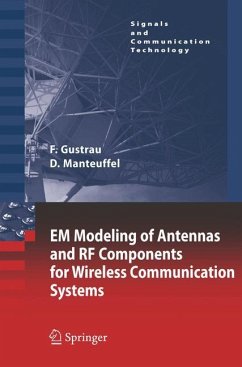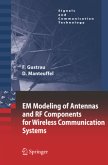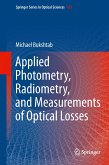This book focuses on practical computational electrodynamics, guiding the reader step-by-step through the modeling process from the initial "what question must the model answer?", through the setting up of a computer model, to post processing, validation and optimization. The book offers a realistic view of the capabilities and limits of current 3-D field simulators and how to apply this knowledge efficiently to EM analysis and design of RF applications in modern communication systems.
Thisbookaddressesnumericalfull-wavemethodsfortheanalysisanddesignof antennas and microwave structures. In the last decades these numerical me- ods that are used to calculate approximate solutions of Maxwell's equations have evolved from pure academic disciplines to powerful and user-friendly - gineering software tools. Meanwhile numerous commercial software packages exist that are widely used in the RF engineering community. Developments in thesoftwareaccompaniedbyprogressincomputertechnologyallownowadays many practical problems to be solved on standard PC systems. The text is written with di?erent groups of readers in mind. First it - dresses RF engineers who embark on numerical modeling using commercial ?eld solvers. Second it addresses graduate students taking practical courses in electromagnetic ?eld simulation. Both groups need a basic understanding of the mathematical background and both groups need a practical introduction tocommercialEMmodelingsoftwaretomaketheir?rstsimulationexperience a success. There are numerous books on the market that deal with mathematical details of di?erent numerical methods for the calculation of electromagnetic ?elds. For engineers who want to know what these methods can do for them and how to use the software tools, these theoretical books are too far away from daily work. On the other hand, there are tutorials and manuals that provide information on how to use speci?c software packages. These tutorials focusonthehandlingandspecialfeaturesofthesoftwareandmethodsapplied therein. However, the theoretical background and broader scope is generally neglected.
Hinweis: Dieser Artikel kann nur an eine deutsche Lieferadresse ausgeliefert werden.
Thisbookaddressesnumericalfull-wavemethodsfortheanalysisanddesignof antennas and microwave structures. In the last decades these numerical me- ods that are used to calculate approximate solutions of Maxwell's equations have evolved from pure academic disciplines to powerful and user-friendly - gineering software tools. Meanwhile numerous commercial software packages exist that are widely used in the RF engineering community. Developments in thesoftwareaccompaniedbyprogressincomputertechnologyallownowadays many practical problems to be solved on standard PC systems. The text is written with di?erent groups of readers in mind. First it - dresses RF engineers who embark on numerical modeling using commercial ?eld solvers. Second it addresses graduate students taking practical courses in electromagnetic ?eld simulation. Both groups need a basic understanding of the mathematical background and both groups need a practical introduction tocommercialEMmodelingsoftwaretomaketheir?rstsimulationexperience a success. There are numerous books on the market that deal with mathematical details of di?erent numerical methods for the calculation of electromagnetic ?elds. For engineers who want to know what these methods can do for them and how to use the software tools, these theoretical books are too far away from daily work. On the other hand, there are tutorials and manuals that provide information on how to use speci?c software packages. These tutorials focusonthehandlingandspecialfeaturesofthesoftwareandmethodsapplied therein. However, the theoretical background and broader scope is generally neglected.
Hinweis: Dieser Artikel kann nur an eine deutsche Lieferadresse ausgeliefert werden.
From the reviews:
"This book aims to fill the gap between pure academic research on the numerical methods of electromagnetic fields and tutorial information on how to use specific software tools. ... It is extremely valuable for engineers and graduates working on EM modeling." (Jizhong Chen, Optics and Photonics News, April, 2007)
"This book aims to fill the gap between pure academic research on the numerical methods of electromagnetic fields and tutorial information on how to use specific software tools. ... It is extremely valuable for engineers and graduates working on EM modeling." (Jizhong Chen, Optics and Photonics News, April, 2007)








